News
Drought-hit Gampaha District walks miles, digs deep for water
View(s):The Gampaha District, which has been relatively free of the drought, is the latest to be affected by it, with villagers compelled to travel five to 10 km to fetch drinking water or, for bathing and washing clothes. Residents of Mirigama, Millawa, Pasyala, Muruthawela, Kal Eliya and Bolakanda are among those severely affected.
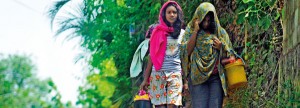
Making the long trek in serach of water. Pix by Amila Gamage
Residents complain of having to travel far from their villages, daily spending an additional Rs 300 to collect water. The Jaya Mawatha village in Pasyala near Mirigama, located on a vast rocky outcrop, has the villagers in a dilemma as they are unable to get pipe borne water due to the elevation, and have no water in the wells.
They say the rock underneath blocks the water flow from fountains to the wells, making them solely dependent on rainwater. Most of the wells in the village are dry, while whatever water there is in the rest, is muddied. The situation is heartbreaking as children go down into the deep wells at night, to try and break the bedrock with crowbars, in search of water.
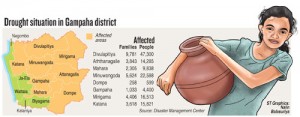 ‚ÄúMy son Harshana Dilan is only 14 but, he has to go into the well daily, risking his life to find water to go to school the next day,‚ÄĚ lamented Thushari Priyadarshani a mother of two, of her son‚Äôs fate. A villager said at least one bowser is required per week for the 47 families in the village,
‚ÄúMy son Harshana Dilan is only 14 but, he has to go into the well daily, risking his life to find water to go to school the next day,‚ÄĚ lamented Thushari Priyadarshani a mother of two, of her son‚Äôs fate. A villager said at least one bowser is required per week for the 47 families in the village,
‚ÄúAfter consuming contaminated water, children are struck down by various illnesses very often. Last week, a child was admitted to the Wathupitiwala hospital, suffering from vomiting, sore throat and other symptoms. Doctors advised to give only previously-boiled water to the children. None of the villagers are government servants, and have no permanent jobs, and we live in severe economic hardship. So how can we afford to buy purified water at exorbitant rates.‚ÄĚ

Moragammana Seelavimala Thera
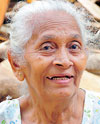
A.D.S Chandrawathi
The villagers also complained of serpents lurking in the area at night, making it dangerous for nocturnal search for water.
A.D.S. Chandrawathi (83) who has been a resident of the area for more than 50 years, said this was the first time she had ever experienced such severe conditions due to a water scarcity.
‚ÄúThe public wells in the area were always full of water in the past. A few decades back, the main livelihood of the villagers was farming. But now, we have completely given up on cultivation, since two years ago.‚ÄĚ Only from a single well in the area is water available for daily needs. The proud owner of the well, K.H.Sugathadasa(60) said long queues form from 4 a.m. until about 10 pm.
‚ÄúMore than 400 people from more than 20 villages, come daily to this well. Some from afar as 10 km.‚ÄĚ Lochana Jayawardena (32), an Ayurvedic practitioner said he had to stop making Ayurvedic medicines for want of water. ‚ÄúAcute damage has been caused to medicinal plant beds. Arista and Kasaya production have been completely stopped, as pure water is key to the preparation of Ayurveda medicines.‚ÄĚ
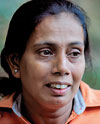
Thushari Priyadarshani
He said the Idiparape District Ayurveda Hospital in Mirigama had been badly hit and a shortage of Ayurvedic medicines can occur as a result.
‚ÄúThe hospital management has sunktube wells to ease the situation,‚ÄĚ he said.
‚ÄúThere is little opportunity to organise a religious ceremony in the village. Bodhi puja have been limited to conserve water,‚ÄĚ said Ven. Moragammana Seelavimala Thera, the chief incumbent of Maligathanna Raja Maha Viharaya, Pasyala. ‚ÄúThe temple has been supplied with pipe-borne water, but we receive water after midnight. So, we use a small tank to store water.‚ÄĚ
Meanwhile, the villagers are planning a Gammdu ceremonial dance to seek divine help to overcome the situation. L.P.A. Samarasiri the village devalaya’s kapumahattaya said the dance will be held on March 4 and 5. ‚ÄúWe hope the circumstances will change after the ceremony. We have firsthand experiences in the past of drought conditions ceasing suddenly, soon after the traditional Gammdu ceremony,‚ÄĚ said some optimistic villagers.
The Bataleeya Water Supply Scheme provides water to Pasyala, Wewaldeniya and Mirigama area residents through a limited number of water spouts. However, due to drought, the demand cannot be met by the National Water Supply & Drainage Board, as the maximum capacity from the Water Supply Scheme is distributed to residents of other areas. Hence, they have stopped providing new water connections.
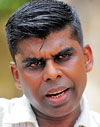
L.P.A Samarasiri
The Divisional Engineer of Gampaha in a letter addressed to the Mirigama residents states that a solution cannot be provided to the people due to the insufficient capacity of the Bataleeya Water Supply Scheme, and the decrease in the water pressure, to distribute to a larger area. Hence, they do not have the technology to distribute water to the area residents of Meerigama.
An officer of the Gampaha Water Board told the Sunday Times that an optimum capacity of water from the Attanagalu Oya is treated and distributed to the people. “However, people use it for other purposes and hence, unable to fulfill their basic needs,” he added.
He added that, due to tide fluctuations salt content has risen in the Raddolu Oya.
‚ÄúLast year, people were provided with drinking water by distributing large tanks in January and March. A maximum capacity of water is treated and distributed through pipelines, while 30 bowsers and tanks were distributed to the Raddolugama residents,‚ÄĚ he said. He said the Maha Oya, Attanagalu Oya and the Kelani Ganga are the main sources of water supply to the Gampaha District.
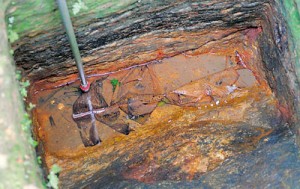
A dried up well
‚ÄúThough the water levels of Maha Oya and Attanagalu Oya have reduced significantly, it does not have a major impact on the supply, in addition to the Kelani ganga’s supply which is normal,‚ÄĚ he said. “As a solution to the problem, new tanks should be constructed, while existing tanks should be dredged so that, sufficient water can be stored. People should stop reclaiming land in water catchment areas, while new methods of water management should be introduced,” he stated.
He stressed that, if the Attanagalla Water Supply Scheme Project is carried out by the authorities, it has the capacity to provide water to a vast area in the Gampaha District, though it would take at least three years to complete.

